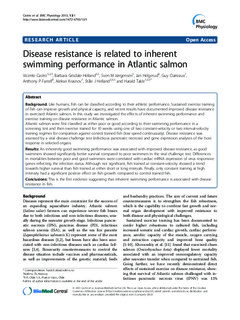| dc.contributor.author | Castro, Vicente | |
| dc.contributor.author | Grisdale-Helland, Barbara | |
| dc.contributor.author | Jørgensen, Sven Martin | |
| dc.contributor.author | Helgerud, Jan | |
| dc.contributor.author | Claireaux, Guy | |
| dc.contributor.author | Farrell, Anthony P. | |
| dc.contributor.author | Krasnov, Aleksei | |
| dc.contributor.author | Helland, Ståle | |
| dc.contributor.author | Takle, Harald Rune | |
| dc.date.accessioned | 2017-12-08T13:14:43Z | |
| dc.date.available | 2017-12-08T13:14:43Z | |
| dc.date.created | 2014-02-04T13:14:50Z | |
| dc.date.issued | 2013 | |
| dc.identifier.citation | BMC Physiology. 2013, 13 (1), . | nb_NO |
| dc.identifier.issn | 1472-6793 | |
| dc.identifier.uri | http://hdl.handle.net/11250/2469810 | |
| dc.description.abstract | Background
Like humans, fish can be classified according to their athletic performance. Sustained exercise training of fish can improve growth and physical capacity, and recent results have documented improved disease resistance in exercised Atlantic salmon. In this study we investigated the effects of inherent swimming performance and exercise training on disease resistance in Atlantic salmon.
Atlantic salmon were first classified as either poor or good according to their swimming performance in a screening test and then exercise trained for 10 weeks using one of two constant-velocity or two interval-velocity training regimes for comparison against control trained fish (low speed continuously). Disease resistance was assessed by a viral disease challenge test (infectious pancreatic necrosis) and gene expression analyses of the host response in selected organs.
Results
An inherently good swimming performance was associated with improved disease resistance, as good swimmers showed significantly better survival compared to poor swimmers in the viral challenge test. Differences in mortalities between poor and good swimmers were correlated with cardiac mRNA expression of virus responsive genes reflecting the infection status. Although not significant, fish trained at constant-velocity showed a trend towards higher survival than fish trained at either short or long intervals. Finally, only constant training at high intensity had a significant positive effect on fish growth compared to control trained fish.
Conclusions
This is the first evidence suggesting that inherent swimming performance is associated with disease resistance in fish. | nb_NO |
| dc.language.iso | eng | nb_NO |
| dc.publisher | BioMed Central | nb_NO |
| dc.rights | Navngivelse 4.0 Internasjonal | * |
| dc.rights.uri | http://creativecommons.org/licenses/by/4.0/deed.no | * |
| dc.title | Disease resistance is related to inherent swimming performance in Atlantic salmon | nb_NO |
| dc.type | Journal article | nb_NO |
| dc.type | Peer reviewed | nb_NO |
| dc.description.version | publishedVersion | nb_NO |
| dc.source.pagenumber | 12 | nb_NO |
| dc.source.volume | 13 | nb_NO |
| dc.source.journal | BMC Physiology | nb_NO |
| dc.source.issue | 1 | nb_NO |
| dc.identifier.doi | 10.1186/1472-6793-13-1 | |
| dc.identifier.cristin | 1109134 | |
| dc.relation.project | Norges forskningsråd: 190067 | nb_NO |
| dc.description.localcode | © 2013 Castro et al.; licensee BioMed Central Ltd. This is an Open Access article distributed under the terms of the Creative Commons Attribution License (http://creativecommons.org/licenses/by/2.0), which permits unrestricted use, distribution, and reproduction in any medium, provided the original work is properly cited. | nb_NO |
| cristin.unitcode | 194,65,25,0 | |
| cristin.unitname | Institutt for sirkulasjon og bildediagnostikk | |
| cristin.ispublished | true | |
| cristin.fulltext | original | |
| cristin.qualitycode | 1 | |

